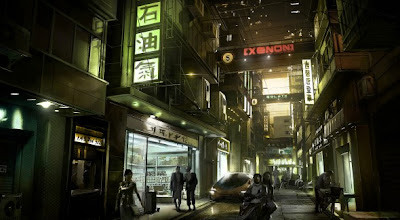I played the first Deus Ex many years ago when it first game out but have never actually got round to finishing it, despite this however I looked forward to it's prequel 'Human Revolution' since it's announcement. There is something about the artistic style, gameplay and theme of the game that got me really interested and excited about it. The guy just looks bad ass.
 Deus Ex: Human Revolution is a science fiction based action role-playing game. Developed by Eidos Montreal, published by Square Enix and released in August 2011. It is the third game in the Deus Ex series, and a prequel to the original game released in 2000.
Deus Ex: Human Revolution is a science fiction based action role-playing game. Developed by Eidos Montreal, published by Square Enix and released in August 2011. It is the third game in the Deus Ex series, and a prequel to the original game released in 2000.The game is set in 2027, 25 years before the first game and follows Adam Jensen, the director of in-house security for a biotechnology firm specialising in human cybernetic enhancement, Sarif Industries. After an industrial terrorist sabotage at Sarif's head quaters Jensen is mortally wounded and forced to undergo radical life-saving surgeries that replace large areas of his body with advanced prostheses. Upon returning to work, he becomes involved in the global politics of the human enhancement movement in the search for those responsible for the attack. The story from then on really drew me in and kept my attention, there are many different twists in the story that keep it interesting and fun. I don't normally get into games over their story but Deus Ex : Human Revolution was great.
Another thing that really made Human Revolution stand out for me was the different "pillars of gameplay", as called by the developers. You can choose how you want to play the game with choices like combat, stealth, hacking and social methods. You can switch between these gameplay types whenever you please with and types flowing well into each other creating dynamic and fun gameplay.
 In the series, Augmentations are technological modifications to the body that allow the user to use superhuman abilities. While augmentations in the first two games were nanotech, Human Revolution is set prior to both and instead features mechanical augmentations. These Augmentations cater to each of the four gameplay types and enhance the your performance in each of the gameplay types, allowing you to craft your own method of play that you prefer. For example, you can choose to priority augmentations that either improve your character's combat prowess or his hacking abilities.
In the series, Augmentations are technological modifications to the body that allow the user to use superhuman abilities. While augmentations in the first two games were nanotech, Human Revolution is set prior to both and instead features mechanical augmentations. These Augmentations cater to each of the four gameplay types and enhance the your performance in each of the gameplay types, allowing you to craft your own method of play that you prefer. For example, you can choose to priority augmentations that either improve your character's combat prowess or his hacking abilities.Unlike in Invisible War, weapons will fire distinct ammunition types instead of depleting a unified pool. They can also be upgraded like in Deus Ex via a variety of so-called "weapon mods" to improve their performance, such as reducing the time it takes to reload, increasing magazine size, adding a laser targeting device for increased accuracy etc.
Another change in Human Revolution is the use of regenerating health. I don't normally like the use of regenerating health in modern games but the change was made because the developers did not want players to get into a situation where they were unable to progress due to low health, and would be forced to "scrounge for med packs" and food. This scrounging behaviour would break the flow of the game when you had to search an entire level for medical supplies.
Perhaps though the biggest draw of the game for me was the overall feel and style of it. The game has a very strong visual style, one that appeals greatly to me.With good gameplay, an interesting story, awesome augmentations and a cool visual style the game was a definite hit for me and I enjoyed every minute.
 |
| The guy is awesomesauce and yes I own this. |





















